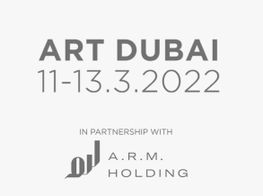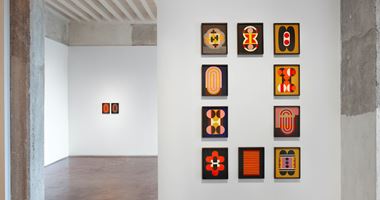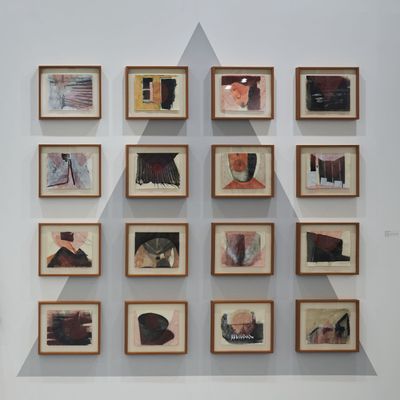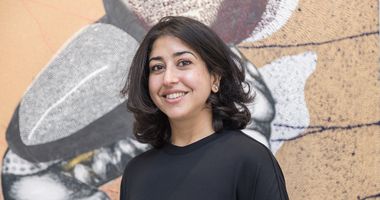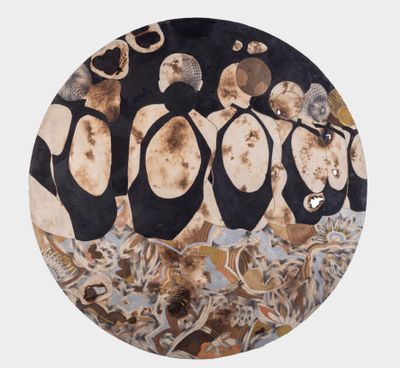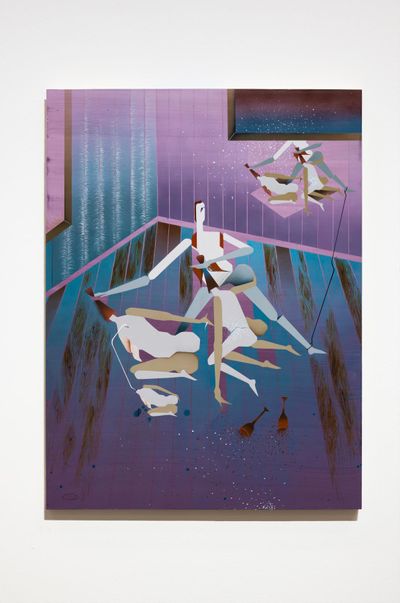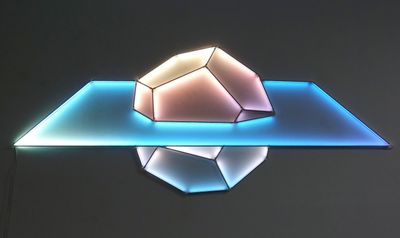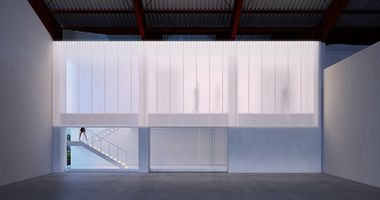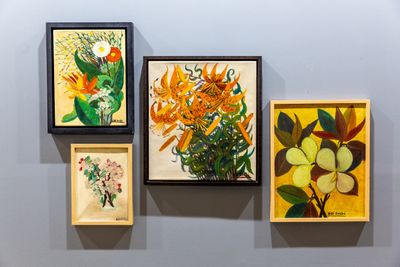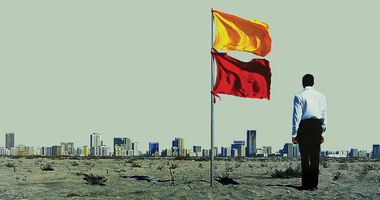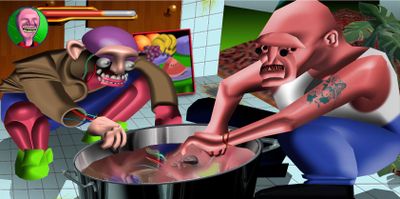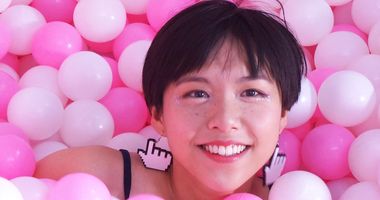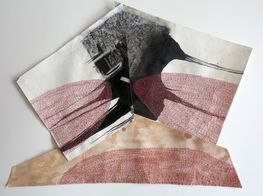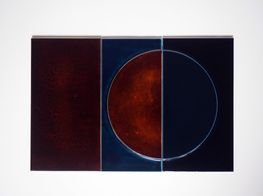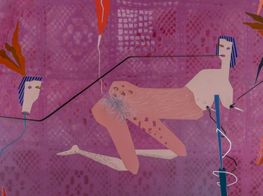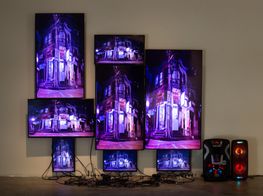Art Dubai 2022: Artist Highlights
The 15th edition of Art Dubai (11–13 March 2022) includes over 100 galleries from 40 countries. Ocula Magazine reports from the ground to bring you highlights from this year's Contemporary, Modern, and Digital sectors.

Lubna Chowdhary, Disobedient typologies 2 (2022). Ceramic multi-object sculptures. 25 x 110 x 110 cm. Exhibition view: Art Dubai (11–13 March 2022). Courtesy Jhaveri Contemporary.
Lubna Chowdhary at Jhaveri Contemporary
Disobedient typologies 2 (2022) is a new work by Lubna Chowdhary, consisting of 36 unglazed black ceramic architectural maquettes, each one roughly the size of a hand.
Minimalist forms and decorative shapes converge in these micro-architectures, with surfaces defined by repetitive geometries—some circular, others angular—as well as rattan flourishes and elements of medieval fortifications.
These forms speak to the wooden sculptures (Erratics 1, 2, and 3, 2021) that Chowdhary showed with PEER in 2021, which drew on the artist's 2017 residency at the V&A in London, where she explored mistranslations of British Victorian and Edwardian domestic designs by Indian craftsmen.
Arranged on a flat table, this abstracted cityscape evades capture while holding space for all manner of projections; an effect that is in keeping with Chowdhary's ceramic abstractions, as with Shifting Structures (2021), a white iteration of this present work.
Radhika Khimji at Experimenter
Among the artists participating in Oman's first national pavilion at the Venice Biennale in 2022, is Radhika Khimji, whose work is rooted in a process of layered mark-making.
On view at Art Dubai, 16 works on photo transfer paper are arranged in rows of four by four atop a grey triangle painted onto the wall (Paperworks, 2019–2020). Each image is united by desert tones; burnt sienna, ochre, and soot, with fine threaded lines creating shapes over washes, drips, and fields of ink-like oil.
Among them, what appears to be an abstracted head is rendered as a long oblong divided by planes of black, grey, and red, atop a low sand triangle; a black circle made of stitches rests on its cheek, while more stitches line the visage.
Three works on birch plywood nearby replicate these threaded marks with points of paint. In Let me see by myself (2021), a central black mass rises from a terrain like a monadnock, defined by rhythmic overlapping lines and dots as a circle of orange bursts above like a firework.
Modupeola Fadugba at Gallery 1957
The bodies of synchronised swimmers rendered in acrylic, graphite, and metal leaf on burned canvas exist like relief forms against black backgrounds.
A line of young women sit on a floor of marbled earth tones with their backs to viewers in Floral Focus (2022), the wide circular void of their black, pro-back cut swimsuits creating a loose pattern across the frame.
Synchronised swimmers form the subject of two series by this self-taught Nigerian artist: 'Tagged' (2015–2017) and 'Synchronized Swimmers' (2016–ongoing).
In both series, synchronised swimming becomes the cipher through which ideas of struggle, competition, and solidarity come through—all of which draw on the artist's experience of navigating the art world, and the decision she made to 'dive in'.
Dilyara Kaipova at Aspan Gallery
To learn the traditional dyeing and weaving practice of abrabandi, Uzbek artist Dilyara Kaipova worked with masters in Margilan, the centre of the weaving industry in Uzbekistan.
Spending months there, she picked up the techniques of the dye process known as ikat, in which vertical threads are knotted and dyed, before being woven with horizontal threads.
The one-time theatre designer and puppet maker was interested in creating hand-woven adras fabrics, a form of ikat woven with a silk and cotton warp, with symbols drawn from popular global culture replacing traditional patterns more commonly associated with garments like the chapan, a gown native to Central Asia.
From these fabrics, Kaipova creates items with patterns rendered with an age-old tradition but feature figures like Batman, Darth Vader, the Stoner Alien, and—in the case of the pink wool coat interwoven with a black pattern at Art Dubai (Mickey, 2021)—Mickey Mouse.
Maryam Hoseini at Green Art Gallery
There is a lot going on in Maryam Hoseini's bodily dramas, defined by figures painted like flat puppets inside abstract architectures accented by fine pencil work, even if it is never made clear what exactly is happening.
There are clues, of course; as is the case with the wine glasses that litter the rooms in two paintings from 2022, on view at Art Dubai: Anxiously One on One and The Window.
In the former, a trio of bodies triangulate in a room where gradated colours of mauve and midnight are punctuated by green reed-like wisps on floor panels, and white lines feathering out from vertical crevices on the wall.
A figure stands over two kneeling women, its ankle tied to the scene's projection on the wall with black thread where its head is cut off by a window looking out to a starry night. A second thread connects one kneeling figure to its smaller avatar in the foreground, as if to visualise the dissociation that comes with inebriation.
Two landscape-format screens line the entrance corridor to Art Dubai, each functioning with a generative software programme that simulates the processes of humidity, whereby fog leads to rain, which manifests as drops on the screen.
Cameras attached to these screens capture the people who pass by, thus rendering their reflections part of the composition, in which figures are abstracted to varying degrees depending on the environmental conditions of their host frame.
Commissioned by Julius Baer, Clar's work was inspired by the process of cloud seeding, a technology used by the U.A.E. to inject suitable clouds with natural salts or hygroscopic agents to enhance rainfall.
Wall works by Clar on view use aluminium slats, L.E.D. lights, and filters to create geometric diagrams of light and line on the wall; Half Submerged (2021), for instance, depicts an iceberg floating in the water.
Wardha Shabbir at Canvas Gallery
Trained in the rendering process known as pardakht, which combines fine dots, some of them the diacritic nuqta mark, to form an image, Wardha Shabbir's new works at Art Dubai pay homage to the legacies of miniature painting while charting pathways for its future.
Detailed visions of luscious gardens and growths are contained in hard-edge geometric shapes—a style Shabbir refers to as 'organic geometry'—some within their frames, others popping against bright backgrounds.
In The Grass Is Breathing (2022), the shape of a room viewed from above is framed by a dark green border, with walls and floors filled with an electrifying density of richly toned flora and foliage, save for a single yellow back wall.
The 2018 Jameel Prize nominee has said that her work is rooted in an exploration of pathways—whether roads she's taken or thought processes she has followed. Works at Art Dubai visualise these channels, like How To Curate A Garden (2022), in which angular foliage panels snake down a yellow ground.
Bibi Zogbé at Agial Art Gallery
While the Lebanese artist Bibi Zogbé was born in 1890 in Sahel Alma, a coastal city west of Beirut, it was in Argentina, where she immigrated at the age of 16, that this cosmopolitan traveller made her name as 'La Pintora de Flores'.
At Art Dubai a series of paintings attest to this reputation, with studies of flowers that speak to a dynamic modernist impulse to capture the vitality of natural forms. In one untitled canvas from 1945, a confident flurry of orange tiger lilies rise above a curl of green leaves, their textures accentuated by the weight of the brush.
Having studied under the Bulgarian painter Klin Dimitrof, Zogbé's first solo exhibition in 1934 at The Witcomb Gallery in Argentina was inaugurated by the Argentine Republic's president, General Agustín P. Justo.
Shows in Paris and Chile followed throughout the 1930s, the latter half of which she would divide her time between Dakar and Paris, where she is known to have visited the Polish painter Tamara de Lempicka, whose portraits of Bibi include Il Fondo Rosa (1923).
Aref El Rayess at Sfeir-Semler Gallery
With an extensive survey show covering five decades of work at the Sharjah Art Museum organised by Sharjah Art Foundation, Sfeir-Semler presents a collection of untitled abstract paintings from the 1960s by Lebanese self-taught artist Aref El Rayess.
Amoeba-like globules of paint overlap and intersect across each panel to create gentle tonal gradations; whether gold, orange, and peach hues in one, or blues and greens in another, through which a self-portrait emerges.
Like many of his 20th-century peers, El Rayess was a cosmopolitan, spending his time between Senegal and Paris between 1948 and 1957, and travelling across Europe and the United States, where he worked in the studios of André Lhote, Fernand Léger, Marcelle Marso, and Ossip Zadkine, before returning to Lebanon in 1957.
El Rayess' practice is as peripatetic as his life's journey, with his Sharjah survey spanning styles and genres, from charged revolutionary paintings and prints from the 1960s and collages focusing on Arab geopolitics from the 1970s to 1990s, to 1980s colour studies rooted in near-abstract landscapes.
Alireza Asadi Zendehjan at Dastan x NFTation
Big up to Art Dubai for creating a digital section that seeks to contextualise the emergent trends in the genre beyond the fetishisation of NFTs, and to Dastan for rising to the challenge.
In partnership with NFTation, the gallery has curated works by two artists: Alireza Asadi Zendehjan and Yousha Bashir, whose paintings of overlapping architectural spaces, elements, and representations also appear in the gallery's booth in the main sector.
Two digital animations by Alireza Asadi Zendehjan are framed within a classic, video arcade machine. Taking up the machine's main screen is the psychedelic Hot Tub (2022) rendered in an acid-coloured mesh of gradated 3D shading and flat two-dimensional distortions, of two figures in a tiled room huddled over a tub of water, with one face turned inside-out.
Screened on the control panel is another work, WAK WAK (2021), which is named after the tree whose pink leaves line the top of the landscape, and whose blue branches and trunks are intertwined with a serpent's body, poised to eat floating human figures.
Gracelee Lawrence at Postmasters Gallery
Art Dubai's new digital section is not just about NFTs, as demonstrated by kinetic 3D-printed sculptures by Gracelee Lawrence, which bring the concept of still-life into the 21st century.
A selection of five prints is presented on a low yellow plinth; each one a pearlescent rendering of a hybridised fruit or vegetable in sharp, luminous colours sitting on a fleshy, brain-like plinth with a rotating top.
There's a sectioned purple strawberry in Strawberry: Trampled or in Your Hands (Rotating) (2022), and a pair of purple lychees in Cherry Blueberry: When Language Fails (Rotating) (2022)—perhaps a reflection of the time the artist spent in Asia as a visiting professor at Chiang Mai University from 2016 to 2017.
More recently, Lawrence has been a visiting assistant professor of Sculpture at the University at Albany, SUNY, in the United States, where she attained an MFA in Sculpture and Extended Media from the University of Texas at Austin in 2016.
Lawrence Lek at SO-FAR x AORA
Lawrence Lek's latest project, Nepenthe Valley, will unfold in three chapters, the first of which, The Source, is being unveiled at Art Dubai in a partnership between SO-FAR and AORA, which will then be shown in the virtual gallery HORIZONS.
At the heart of the project, curated by Jenn Ellis, are concepts and practices of meditative healing. The title of Nepenthe Valley comes from the name of a medicine for memory drawn from Greek mythology.
Hence, the 3D models in the booth draw on temple architectures from antiquity and are translated into NFTs that show digital renderings atop contemporary ruins and rugged landscapes.
In a gesture that links Dubai with Singapore, which have both become cryptocurrency hubs in recent years, Lek's project will culminate with its final chapter, The Point, during Singapore Art Week in 2023. —[O]


